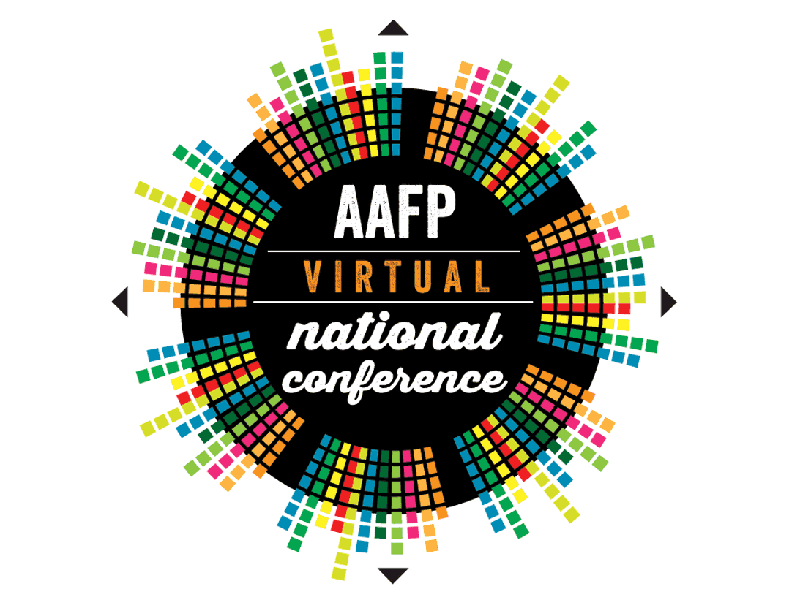2021 National Conference
Panelists Outline Anti-racism Advocacy Strategies for Students
August 12, 2021, 4:37 p.m. News Staff — Medicine plays a distinct role in propagating racism in this country — and medical students have a unique imperative to push back. That was the powerful message of “Sounding the Alarm: Six Strategies Medical Students Can Use to Champion Anti-Racism Advocacy,” a July 29 mainstage presentation at the 2021 National Conference of Family Medicine Residents and Medical Students.

The energetic half-hour centered on a paper that the panelists — J. Nwando Olayiwola, M.D., M.P.H.; Deborah Fadoju; and Rosevine Azap; all of Columbus, Ohio — published together in December 2020, also titled “Sounding the Alarm.” Fadoju and Azap are third-year medical students at the Ohio State University College of Medicine, where Olayiwola was until recently professor and chair of the Department of Family and Community Medicine. Humana this year hired Olayiwola to be the insurer’s first chief health equity officer.
The panelists began with a high-level summary of the international tumult following the murder by police of George Floyd in Minneapolis last year: 20 million protesters worldwide and widespread acknowledgement of racism as a public health crisis.
“It felt like the world stood up to wholeheartedly agree that the longstanding, inadequately addressed inequities that are ever-present in police violence are intimately tied to systemic racism,” Fadoju said.
“But not in medicine, right?” she added.
The next slide answered with a single word set against a photo of a Floyd-related protest: “Wrong.”
Story Highlights
The effects of systemic racism have been tragically visible during the COVID-19 public health emergency, the panelists said, with the pandemic underscoring already stark connections linking racism, social determinants of health and poor outcomes, and Black patients dying of the virus at more than twice the fatality rate for white patients.
Exacerbating the problem: medicine’s historic lack of diversity, another self-perpetuating cycle the panelists identified with numbers: 38% of medical students from underrepresented racial and ethnic groups report mistreatment, Black people represent a paucity of full-time faculty at medical schools and 14% of second-year medical students believe Black people’s nerve endings are less sensitive than those of white people.
Overcoming these and other obstacles to diversify the physician workforce and improve patient outcomes, the panelists suggested, will require forceful activism from coming generations of physicians. To rally the dozens of future family physicians attending the virtual presentation, Olayiwola, Fadoju and Azap laid out six strategies for medical students to champion anti-racism efforts in their programs and communities (and cataloged examples, and some notable wins, from their own efforts in Ohio):
- Embrace a common agenda. For the panelists, this took the form of offering an “emotional outlet” for peers affected by Floyd’s killing, then banding together to advocate for new anti-racism policies.
- Establish a formal structure. Here, the panelists cited the White Coats for Black Lives platform.
- Engage affinity groups and allies.
- Endorse legislative action. Within and outside institutions, they said, “use collective voices to demonstrate to decision-makers, leaders and stakeholders the need for change.”
- Encourage curricular reform.
- Enrich the pipeline.
Activism conducted by medical students, the panelists’ paper notes, “can push the profession to be one that dares to solve problems not directly within its purview, but also problems that expand far beyond the reach of hospital beds or operating rooms and into the deep spaces of social reform.”
They add: “Medical students should not be passive partakers, but rather critical evaluators of their own medical education. Students should call attention to ways in which professors can incorporate social determinants of health, social justice advocacy, and health equity into medical education.”
Parallel AAFP Advocacy
The AAFP last year asked CMS to help educate physicians about implicit bias and build strategies to address the issue by supporting culturally appropriate patient-centered care. The Academy in 2020 also advised the Domestic Policy Council that the United States should “officially recognize racism as a public health issue and declare a public health emergency to address the negative impacts racism is having on the physical and mental well-being of millions of people” and coordinate a federal response to systemic racism.
These calls to action were in line with work done by the AAFP’s Center for Diversity and Health Equity, which launched in 2017 and counts among its goals the elimination of institutional racism. To that end, the Academy offers members the EveryONE Project’s Implicit Bias Training Guide and Neighborhood Navigator, tools to help family physicians recognize and address unconscious biases, identify patients’ social needs and connect them to resources, and raise awareness of underlying drivers of health disparities.
During the conference, the Academy announced its participation in Equity Matters, a Council of Medical Specialty Societies initiative focused on diversity, equity, inclusion and anti-racism.